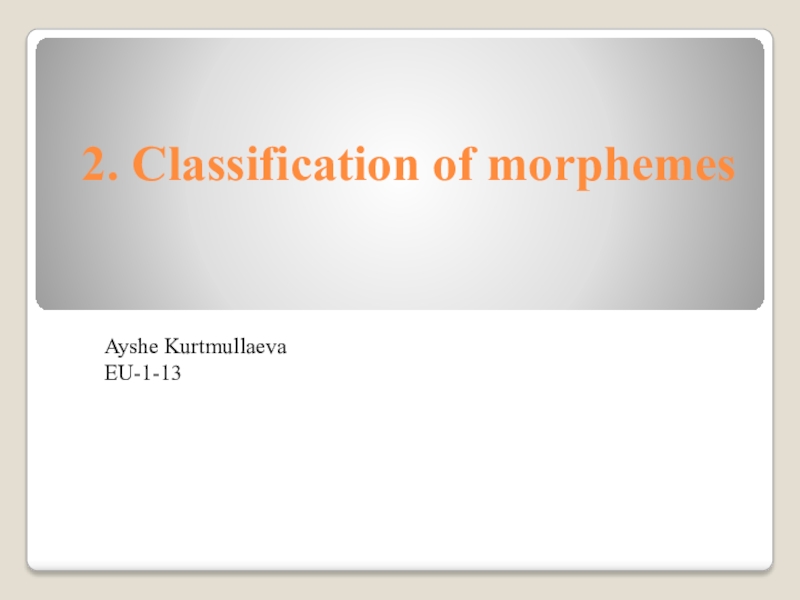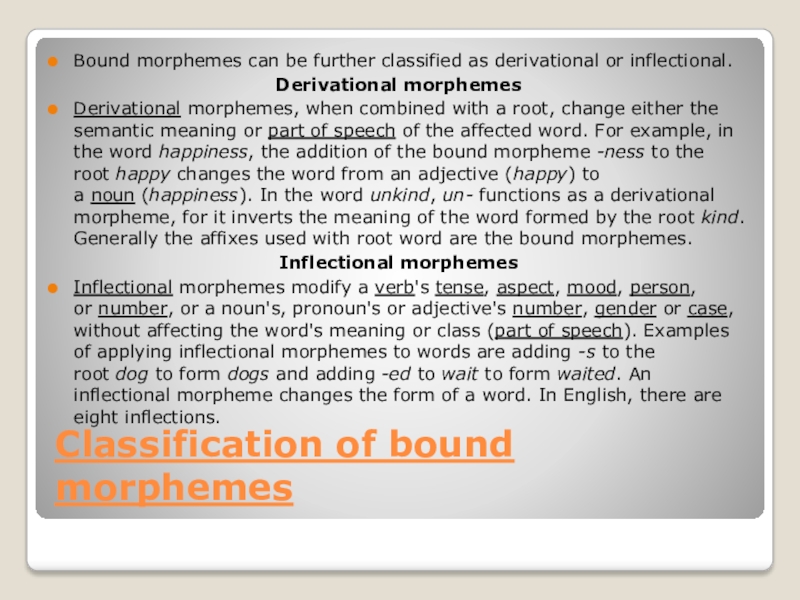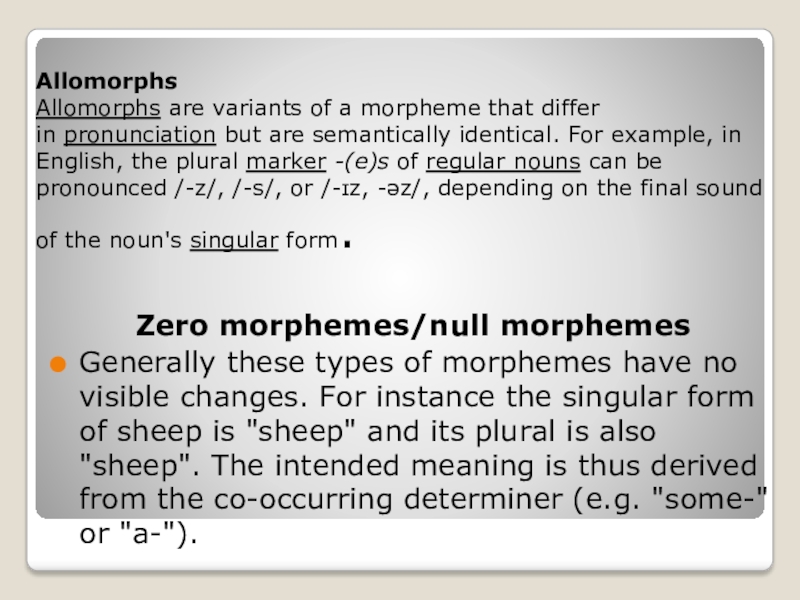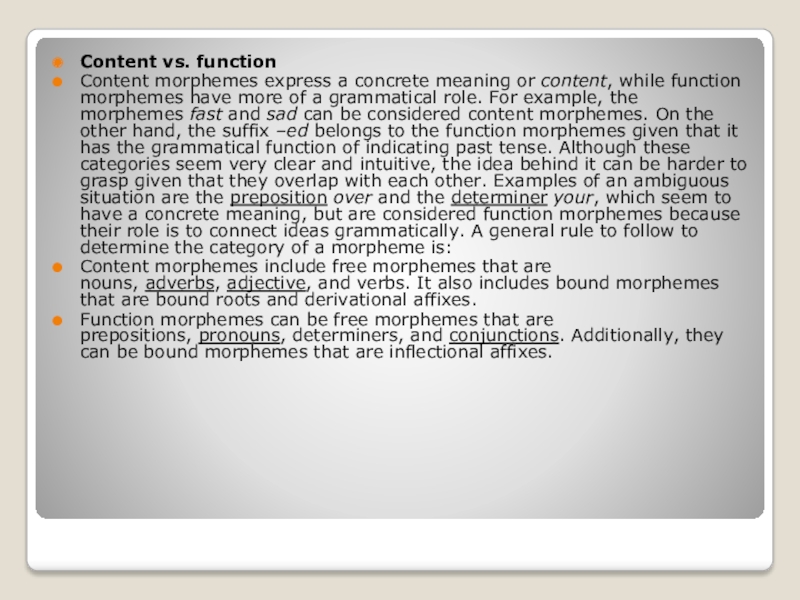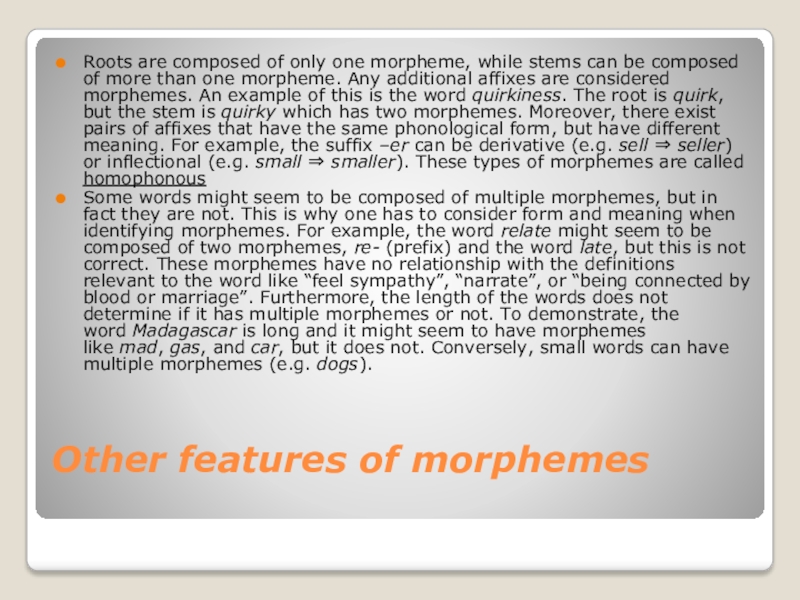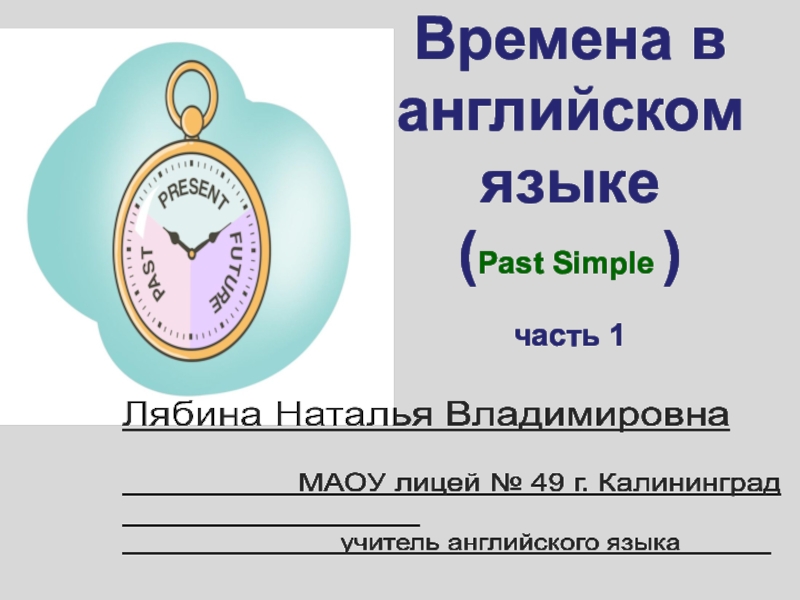- Главная
- Разное
- Образование
- Спорт
- Естествознание
- Природоведение
- Религиоведение
- Французский язык
- Черчение
- Английский язык
- Астрономия
- Алгебра
- Биология
- География
- Геометрия
- Детские презентации
- Информатика
- История
- Литература
- Математика
- Музыка
- МХК
- Немецкий язык
- ОБЖ
- Обществознание
- Окружающий мир
- Педагогика
- Русский язык
- Технология
- Физика
- Философия
- Химия
- Шаблоны, фоны, картинки для презентаций
- Экология
- Экономика
Презентация, доклад на тему Presentation on the English Lexicology Classification of morphemes
Содержание
- 1. Presentation on the English Lexicology Classification of morphemes
- 2. Free and bound morphemes Every morpheme can
- 3. Classification of bound morphemes Bound morphemes can
- 4. Allomorphs Allomorphs are variants of a morpheme that
- 5. Content vs. functionContent morphemes express a concrete
- 6. Other features of morphemes Roots are composed
- 7. Слайд 7
Free and bound morphemes Every morpheme can be classified as either free or bound. These categories are mutually exclusive, and as such, a given morpheme will belong to exactly one of them.Free morphemes can function independently as
Слайд 2Free and bound morphemes
Every morpheme can be classified as either free
or bound. These categories are mutually exclusive, and as such, a given morpheme will belong to exactly one of them.
Free morphemes can function independently as words (e.g. town, dog) and can appear with other lexemes (e.g. town hall, doghouse).
Bound morphemes appear only as parts of words, always in conjunction with a root and sometimes with other bound morphemes. For example, un- appears only accompanied by other morphemes to form a word. Most bound morphemes in English are affixes, particularly prefixes and suffixes. Examples of suffixes are -tion, -ation, -ible, -ing, etc. Bound morphemes that are not affixes are called cranberry morphemes.
Free morphemes can function independently as words (e.g. town, dog) and can appear with other lexemes (e.g. town hall, doghouse).
Bound morphemes appear only as parts of words, always in conjunction with a root and sometimes with other bound morphemes. For example, un- appears only accompanied by other morphemes to form a word. Most bound morphemes in English are affixes, particularly prefixes and suffixes. Examples of suffixes are -tion, -ation, -ible, -ing, etc. Bound morphemes that are not affixes are called cranberry morphemes.
Слайд 3Classification of bound morphemes
Bound morphemes can be further classified as derivational
or inflectional.
Derivational morphemes
Derivational morphemes, when combined with a root, change either the semantic meaning or part of speech of the affected word. For example, in the word happiness, the addition of the bound morpheme -ness to the root happy changes the word from an adjective (happy) to a noun (happiness). In the word unkind, un- functions as a derivational morpheme, for it inverts the meaning of the word formed by the root kind. Generally the affixes used with root word are the bound morphemes.
Inflectional morphemes
Inflectional morphemes modify a verb's tense, aspect, mood, person, or number, or a noun's, pronoun's or adjective's number, gender or case, without affecting the word's meaning or class (part of speech). Examples of applying inflectional morphemes to words are adding -s to the root dog to form dogs and adding -ed to wait to form waited. An inflectional morpheme changes the form of a word. In English, there are eight inflections.
Derivational morphemes
Derivational morphemes, when combined with a root, change either the semantic meaning or part of speech of the affected word. For example, in the word happiness, the addition of the bound morpheme -ness to the root happy changes the word from an adjective (happy) to a noun (happiness). In the word unkind, un- functions as a derivational morpheme, for it inverts the meaning of the word formed by the root kind. Generally the affixes used with root word are the bound morphemes.
Inflectional morphemes
Inflectional morphemes modify a verb's tense, aspect, mood, person, or number, or a noun's, pronoun's or adjective's number, gender or case, without affecting the word's meaning or class (part of speech). Examples of applying inflectional morphemes to words are adding -s to the root dog to form dogs and adding -ed to wait to form waited. An inflectional morpheme changes the form of a word. In English, there are eight inflections.
Слайд 4Allomorphs Allomorphs are variants of a morpheme that differ in pronunciation but are semantically identical.
For example, in English, the plural marker -(e)s of regular nouns can be pronounced /-z/, /-s/, or /-ɪz, -əz/, depending on the final sound of the noun's singular form.
Zero morphemes/null morphemes
Generally these types of morphemes have no visible changes. For instance the singular form of sheep is "sheep" and its plural is also "sheep". The intended meaning is thus derived from the co-occurring determiner (e.g. "some-" or "a-").
Слайд 5Content vs. function
Content morphemes express a concrete meaning or content, while function
morphemes have more of a grammatical role. For example, the morphemes fast and sad can be considered content morphemes. On the other hand, the suffix –ed belongs to the function morphemes given that it has the grammatical function of indicating past tense. Although these categories seem very clear and intuitive, the idea behind it can be harder to grasp given that they overlap with each other. Examples of an ambiguous situation are the preposition over and the determiner your, which seem to have a concrete meaning, but are considered function morphemes because their role is to connect ideas grammatically. A general rule to follow to determine the category of a morpheme is:
Content morphemes include free morphemes that are nouns, adverbs, adjective, and verbs. It also includes bound morphemes that are bound roots and derivational affixes.
Function morphemes can be free morphemes that are prepositions, pronouns, determiners, and conjunctions. Additionally, they can be bound morphemes that are inflectional affixes.
Content morphemes include free morphemes that are nouns, adverbs, adjective, and verbs. It also includes bound morphemes that are bound roots and derivational affixes.
Function morphemes can be free morphemes that are prepositions, pronouns, determiners, and conjunctions. Additionally, they can be bound morphemes that are inflectional affixes.
Слайд 6Other features of morphemes
Roots are composed of only one morpheme, while
stems can be composed of more than one morpheme. Any additional affixes are considered morphemes. An example of this is the word quirkiness. The root is quirk, but the stem is quirky which has two morphemes. Moreover, there exist pairs of affixes that have the same phonological form, but have different meaning. For example, the suffix –er can be derivative (e.g. sell ⇒ seller) or inflectional (e.g. small ⇒ smaller). These types of morphemes are called homophonous
Some words might seem to be composed of multiple morphemes, but in fact they are not. This is why one has to consider form and meaning when identifying morphemes. For example, the word relate might seem to be composed of two morphemes, re- (prefix) and the word late, but this is not correct. These morphemes have no relationship with the definitions relevant to the word like “feel sympathy”, “narrate”, or “being connected by blood or marriage”. Furthermore, the length of the words does not determine if it has multiple morphemes or not. To demonstrate, the word Madagascar is long and it might seem to have morphemes like mad, gas, and car, but it does not. Conversely, small words can have multiple morphemes (e.g. dogs).
Some words might seem to be composed of multiple morphemes, but in fact they are not. This is why one has to consider form and meaning when identifying morphemes. For example, the word relate might seem to be composed of two morphemes, re- (prefix) and the word late, but this is not correct. These morphemes have no relationship with the definitions relevant to the word like “feel sympathy”, “narrate”, or “being connected by blood or marriage”. Furthermore, the length of the words does not determine if it has multiple morphemes or not. To demonstrate, the word Madagascar is long and it might seem to have morphemes like mad, gas, and car, but it does not. Conversely, small words can have multiple morphemes (e.g. dogs).
